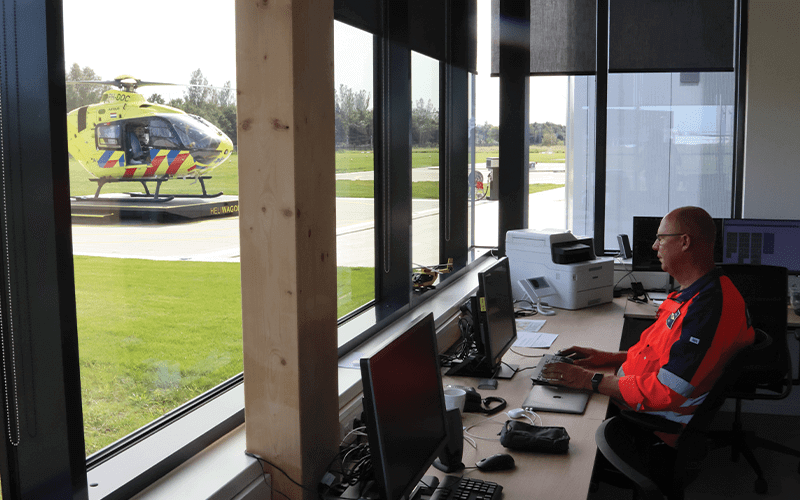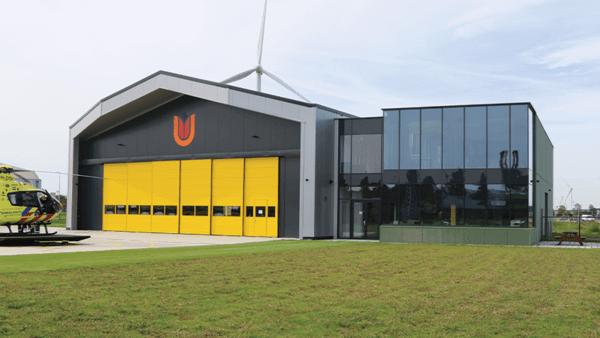Gallery: Lifeliner 1 moves to new base station

Invited to see for himself, Peter Ten Berg went to the outskirts of Amsterdam where the newly relocated base station of Lifeliner 1 is proving more efficient and sustainable
After years of planning and constructing a new operations station, the Amsterdam helicopter emergency medical services (HEMS) unit, Lifeliner 1, finally left its rooftop base at the Vrije Universiteit medical center (VUmc) for its new home during the second half of 2023. The decision to move Lifeliner 1 outside of Amsterdam’s city center was a result of population growth near the former station and an ongoing annual rise in the need for HEMS emergency responses, reaching more than 2,300 per year.
Lifeliner 1 is one of four Dutch regional HEMS units, and was the last to vacate its base of operations from a residential area. Collectively, the four Airbus H135s respond to approximately 10,000 emergency calls across the Netherlands each year.
Lifeliner 1 comprises a mobile medical team with a helicopter and ground car to shuttle an emergency doctor and nurse to the scene of an incident when urgent specialist care is needed. At the base, the helicopter lands on an electric remote-controlled dolly so that the aircraft can easily be maneuvered into and out of the hangar without exertion from the crew.
Heliport Amsterdam was not entirely new to the team, as Chief Pilot Frans Fuhrmann explained: “This station was already one of our options to refuel and secure our continuous availability to emergency responses. Now we have here our own office, housing and hangar facilities. The hangar is wide enough to house two helicopters, allowing us to do some small maintenance and cleaning on station.”
The new building is constructed in such a way that all work areas are very close to the helicopter and ambulance car. Dr Carolien Bulte described the benefits of the new site: “At our previous station, we had to take several stairs to reach the roof, so the new building offers us a better response to the emergency calls.” She continued: “On our way out to the helicopter, we also pass the cooling unit where we store several units of blood plasma, which we take with us in a special carry-on container when deployed. Furthermore we have an in-house pharmacy where we store our medical supplies to replenish after each emergency. Our suppliers can enter a shielded and locked room of our building, so they can also bring or pick up goods even when we are out flying.”
A member of the project team, Fuhrmann was aware of the requirements needed from a new and bespoke base: “The building has six individual rooms with a bed and bathroom, which is essential to run our 24/7 emergency service. Additionally the building is constructed according to high sustainable criteria, with low energy consumption and well insulated to hold its warmth in the winter and keeping it cool during summer.”
Though it will no longer be a base station, the VUmc hospital rooftop helideck will remain open for use to fly in patients or to pick up a HEMS doctor after accompanying the patient by ground ambulance. The change is estimated to reduce the approximately 4,760 flights at the Amsterdam hospital to just 760 annually.

March 2024
Issue
In the March edition, get transported in flying medical units; see how digital cockpits can improve your workload; discover how different firefighters use different tools, equipment and craft; and discover the innovations and improvements to aerial firefighting coming out of the American west coast; plus more of our regular content.
Peter Ten Berg
Inspired by the dynamics of aviation and a passion for photography, Peter accompanies aircraft and helicopter crews to capture them at work and hear their story for his exclusive reports. His focus is on military aviation as well as governmental subjects including HEMS, SAR, UAV and rescue.








